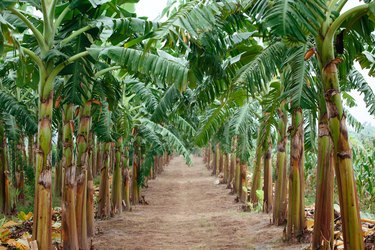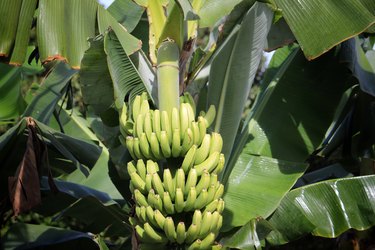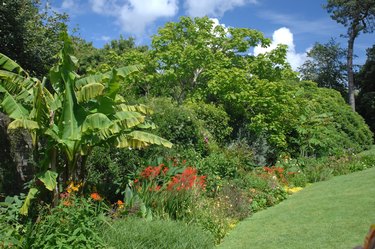If you're looking for a plant that will bring a bit of tropical drama to your house or garden, bananas (Musa spp.) will certainly do that. Their large leaves and long blossom spikes are decidedly eye-catching, whether you grow them outdoors in warm climates or as a houseplant anywhere else.
Gardeners in the warmest areas can consider standard commercial varieties like Cavendish bananas (Musa acuminata, USDA plant hardiness zones 10 to 11) or plantains (Musa balbisiana, zones 9 to 12), but there are others that can survive and flourish in cooler climates. They're easier to grow than you might think, but it helps to understand the plants' structure before you get started.
Video of the Day
Video of the Day

Surprise! Bananas Are Herbs
Most people tend to think of bananas as just one of the world's many fruit trees, but that's incorrect. In fact, botanists class the banana family (Musaceae) as oversized herbs, which grow from rhizomes (underground horizontal stems). They're cousins to a range of other plants with a similar growth habit, which includes other important food crops (ginger, galangal, turmeric) and ornamentals (bird of paradise). This whole order of plants is referred to as the Zingiberales, from the scientific name for ginger (Zingiber officinale).
It's important to understand this if you want to experiment with growing bananas because it requires a shift of mental gears. You're not dealing with a typical fruit tree with a woody trunk and branches, and if you approach banana growing in that spirit, you're going to hit some speed bumps. So, let's take a detailed look at the banana plant's structure and then move on to how to grow and propagate bananas successfully.

Anatomy of a Banana Plant
One of the most important parts of a banana plant is one you don't see: its rhizome, i.e., the fleshy root system that stores energy to produce new stems (as bulbs, corms and tubers do in other plants). It's similar to fresh ginger, though on a larger scale. The roots of a banana tree can be as wide as 30 inches and up to 5 feet deep, but on average they grow to be around 18 inches or less.
Although they resemble palm trees, the stalks that grow the bananas are actually called pseudostems. They're the stems of the large banana leaves that grow at the top and remain behind as the leaves die away and are replaced. After enough of these stems accumulate, they begin to resemble a tree trunk that can soar up to 20 feet high depending on the variety of banana. By the time the plants produce fruit, you'll have 10 to 20 leaves at the top of the plant, each of which can be 10 to 11.5 inches wide.
Common Banana Varieties
Cavendish bananas account for most of what you’ll see at the supermarket, but there are thousands of others. A few are notable, either because they’re popular in some markets or are well suited for home growing. A few of those include:
- Red Dacca: These have red peels and pink creamy flesh. They are usually softer and sweeter than Cavendish.
- Gros Michel (aka “Big Mike”): These are the main commercial banana before Cavendish and are slightly larger and sweeter. They were hit hard by disease, which is why the industry turned to Cavendish, but they are still grown in some areas.
- Blue Java: This well-known banana hybrid has a taste and texture that are compared to ice cream. (In fact, they’re sometimes called “ice cream bananas.”) Their peels turn yellow and spotted as they ripen, but the fruit has a blue color that deepens with maturity.
- Lady Finger: This is called the “sugar banana” because of its flavor. They’re very popular in southeast Asia, and at 3 inches or so, they are one of the smallest types of bananas to be grown commercially.
- Musa Basjoo (aka “Japanese banana”): This one’s important for gardeners because it’s hardy to zone 5. It won’t produce edible fruit, but it will overwinter reliably in much of the U.S. and will still give you plenty of banana flowers and an exotic, tropical appearance.
The banana fruits start out as a spike of yellow flowers protected by red or purple bracts (the leafy part of the bud), which appear at the top of the trunks. The blossoms grow in clusters of about 10 to 20, which will become the "hands" of fruit (technically, bananas are a berry!). A healthy banana plant can produce up to 50 to 150 fruits at a time, but it only produces one crop from that stem. Afterward, growers cut down the now dead stem.
New shoots called "pups" arise from the rhizome about every six months, clustered around the mother plant. Growers select a strong pup and cut off the others, and that pup then becomes the next crop's productive stem.

Growing Banana Plants Outdoors
Banana plants are native to humid, tropical regions and do best in temperatures ranging from 80 to 95 degrees Fahrenheit. That fundamental requirement is going to determine whether you opt to grow your bananas indoors or out. If you don't live in a tropical or subtropical climate, indoors is your better option.
If you do choose to grow outdoors, most bananas require full sun, though a few prefer light shade. They should be planted in loamy, well-draining soil with a pH of 5.5 to 6.5 and lots of organic material since they're heavy feeders. Plant them in clumps, as their shallow roots benefit from the added support. A single plant can easily be wind-damaged, but a clump of them will protect each other.
For the best fruit yields, choose a sheltered spot that will protect the plants from strong winds. They'll need a lot of water during the growing season—one heavy watering each day or up to three lighter waterings with sprinklers. Fertilize your banana plants once a month with a complete fertilizer but do not let that touch the leafy trunk. You may need to increase your watering if the weather is especially hot and dry. You can propagate banana plants by dividing the rhizome or removing a pup from the mother plant once it has roots and then transplanting it.
While bananas in general are tropical plants, there are banana varieties that can survive in climates as cold as zone 5. If you consult your local nurseries or use a search term like "cold-hardy banana trees" in your favorite search engine, you should find several suitable options from which to choose. (Yeah, they're not trees, but that still works for Googling purposes!)

Growing Banana Plants Indoors
Commercial cultivars are usually too large to be houseplants, but there are smaller ones better suited to indoor use. The dwarf Cavendish banana tops out at 10 feet in height, and there are plenty of "dwarfier" varieties that are even smaller.
To grow a banana plant indoors, choose the largest pot you can comfortably manage, especially if you'll be moving it outdoors in summer. It should have drainage holes, and you'll need a potting mix that doesn't retain water because soil that is too wet will result in root rot. Position your plant in direct sunlight wherever possible.
It's important to understand that you probably won't get edible fruit from your banana plant. Most varieties need truly tropical conditions (hot, sunny and humid) that are hard to provide in your actual living space, but determined home growers can harvest their own fruit from a greenhouse plant or a few niche cultivars that yield fruit in cooler climates.
Propagation is the same as for outdoor bananas. You can use the new plants in other areas of your home or give them away to friends and family who have admired your plant.
